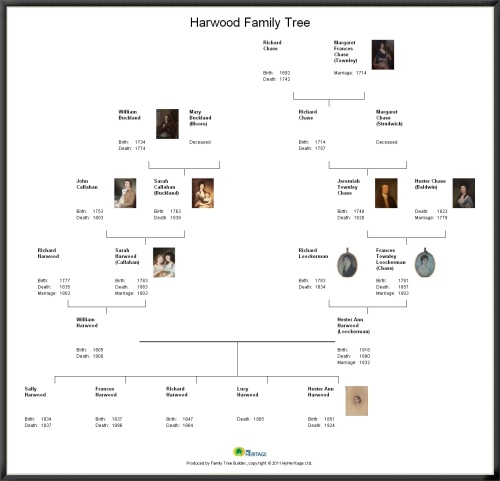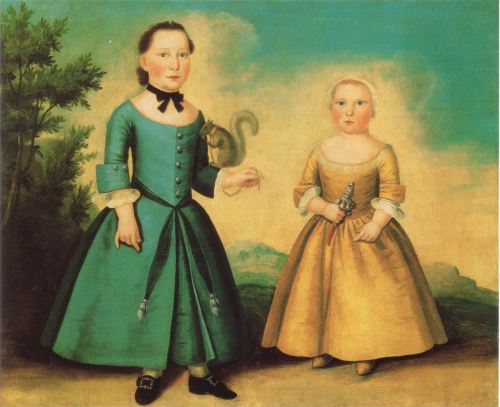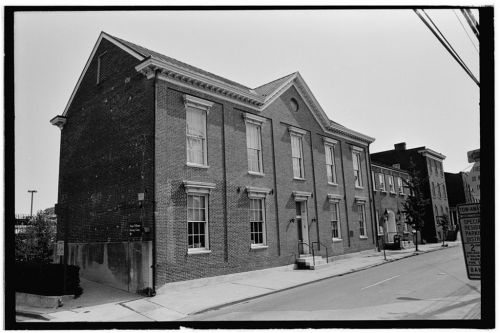I decided another fashion-related post was called for when I saw this photo. I think that this image is part of a series of postcards produced while St. John’s College owned the House, between 1926 and 1940. Obviously, it’s a 20th-century view of 18th-century fashion. The accuracy of their costumes leaves a bit to be desired, but I’m sure they felt fabulous in their Marie Antoinette wigs and enormous side hoops. I think that the docents at the House gave tours in costumes like these. Somehow I don’t think I could talk our current docents into wearing outfits this fabulous…
Monthly Archives: July 2011
Friday Photo: A New Concealment Shoe
This is the inside of the cornice on the Hammond-Harwood House roof:
 Since we removed the original concealment shoe we found up there during our roof restoration, we needed a replacement. After all, we wouldn’t want bad luck or evil spirits to take advantage of our lack of protection. Executive Director Carter Lively was, after much prodding, convinced to place a pair of his much-loved shoes in the cornice to guarantee that the house stays safe for another 237 years.
Since we removed the original concealment shoe we found up there during our roof restoration, we needed a replacement. After all, we wouldn’t want bad luck or evil spirits to take advantage of our lack of protection. Executive Director Carter Lively was, after much prodding, convinced to place a pair of his much-loved shoes in the cornice to guarantee that the house stays safe for another 237 years.
Filed under Friday Photo, Restoration
Family Tree
One of the new docents at the Hammond-Harwood House asked me to clarify how the descendants of William Buckland, the architect who designed the House, eventually came to live in it. I tried to explain it, but quickly realized that a visual aid would make both of our lives much easier. So I spent yesterday afternoon playing with a free family tree tool I found online, and now (hopefully) it is easy to see that William Harwood married Hester Ann Loockerman, whose grandfather Jeremiah Townley Chase had purchased the house for his daughter Frances Chase Loockerman and her family in 1811. William and Hester’s youngest daughter, Hester Ann, was the last private resident of the House.
Click on the family tree to enlarge it, and let me know if you have any more Chase/Loockerman/Buckland/Callahan/Harwood information for me to add.

Friday Photo: For Baby
 My neighbors had a baby recently, and watching them put her in her stroller recently made me think about how much stuff babies seem to require. Clothes, diapers, blankets, bottles, strollers, seats, toys…the list goes on and on and on. Eighteenth century babies didn’t require quite as much specialized equipage, but today’s photo shows one item every upper-class baby would have found useful. This is an 18th century silver baby rattle, complete with a whistle, bells, and a piece of coral for a teething baby to gnaw on. These were so identified with childhood that you can see children holding them in portraits like this one from the collection of Colonial Williamsburg:
My neighbors had a baby recently, and watching them put her in her stroller recently made me think about how much stuff babies seem to require. Clothes, diapers, blankets, bottles, strollers, seats, toys…the list goes on and on and on. Eighteenth century babies didn’t require quite as much specialized equipage, but today’s photo shows one item every upper-class baby would have found useful. This is an 18th century silver baby rattle, complete with a whistle, bells, and a piece of coral for a teething baby to gnaw on. These were so identified with childhood that you can see children holding them in portraits like this one from the collection of Colonial Williamsburg:

"Portrait of Two Children" attributed to Joseph Badger. Abby Aldrich Rockefeller Folk Art Museum, 57.100.15
Don’t be fooled by the dress – the child holding the rattle could be a boy. Yet another thing that’s changed since the 18th century…
Filed under Collections, Friday Photo, History
Ssh, I’m Reading
Today is one of those days when I tell you to go read something other than my blog. Specifically, this book:
 Jane McWilliams spent years researching and writing this comprehensive history of Annapolis, and it shows. The book covers the evolution of the town from 1649 to 1975 in with an amazing amount of detail. Should you feel the need to rush out and get a copy for yourself (which you should), the book is now for sale in the Hammond-Harwood House Museum Store. Members receive a 10% discount.
Jane McWilliams spent years researching and writing this comprehensive history of Annapolis, and it shows. The book covers the evolution of the town from 1649 to 1975 in with an amazing amount of detail. Should you feel the need to rush out and get a copy for yourself (which you should), the book is now for sale in the Hammond-Harwood House Museum Store. Members receive a 10% discount.
Filed under History
Friday Photo: Vintage Hammond-Harwood

 I was feeling uninspired for this week’s edition of Friday Photo, so I did a quick Google Image Search for Hammond-Harwood House. These vintage postcards turned up, and I spent a significant amount of time marveling at how much our ballroom has changed. There’s no date on the postcards, but they’re definitely mid-20th century. Many of the pieces of furniture shown (and those amazing gold silk valances) are still in our collection, but the way in which they’re displayed is so different. The postcards show a ballroom that is beautiful and full of ornate objects, but looks untouched. Today, we try to give visitors to the House a better idea of how the room could actually have been used, with chairs pulled up to a set tea table and music books open on stands. Although I would be tempted to pull those gold valances out of storage, if they wouldn’t just blend in with the yellow paint now on the walls.
I was feeling uninspired for this week’s edition of Friday Photo, so I did a quick Google Image Search for Hammond-Harwood House. These vintage postcards turned up, and I spent a significant amount of time marveling at how much our ballroom has changed. There’s no date on the postcards, but they’re definitely mid-20th century. Many of the pieces of furniture shown (and those amazing gold silk valances) are still in our collection, but the way in which they’re displayed is so different. The postcards show a ballroom that is beautiful and full of ornate objects, but looks untouched. Today, we try to give visitors to the House a better idea of how the room could actually have been used, with chairs pulled up to a set tea table and music books open on stands. Although I would be tempted to pull those gold valances out of storage, if they wouldn’t just blend in with the yellow paint now on the walls.
Filed under Friday Photo
Lunch with Jefferson?
Anyone who knows me knows how important food is to me; lunchtime is often a highlight of my workday. Today, I’d think I’d like to have a “Monticello salad,” which would include “a mixed bouquet of greens, including spinach and endive for winter use, orach, corn salad or mache, pepper grass, French sorrel, cress, and sprouts.” Apparently Thomas Jefferson really liked food too, and grew an impressive variety of vegetables at Monticello. He also liked wine; when he returned to America from France after serving as America’s minister there, he brought back 680 bottles. I learned these and other fun Jefferson food-related facts in a fabulous blog post at http://b-womeninamericanhistory18.blogspot.com/. Careful – it might make you hungry.
Filed under History
Friday Photo: Dancing With Joy
This blog has had over 1,000 page views! Since that statistic has me dancing with joy around my office, I thought I would show you where 18th century Annapolitans did their dancing. This photograph, taken by the Historic American Buildings Survey, shows the Assembly Rooms at 150 Duke of Gloucester Street.
 The building was added to in the 19th century, but the section in the front of the photograph was built in 1767 and used for the legislature while the State House was under construction. It also served as a space for balls and other social functions. A letter from the late 18th century describes the ballroom with smaller spaces used for gaming at either end, and served as the inspiration for the interpretation of the Gaming Room here at Hammond-Harwood House. To see the Assembly Rooms page from the Historic American Buildings Survey (where I found this photo), click here.
The building was added to in the 19th century, but the section in the front of the photograph was built in 1767 and used for the legislature while the State House was under construction. It also served as a space for balls and other social functions. A letter from the late 18th century describes the ballroom with smaller spaces used for gaming at either end, and served as the inspiration for the interpretation of the Gaming Room here at Hammond-Harwood House. To see the Assembly Rooms page from the Historic American Buildings Survey (where I found this photo), click here.
Filed under Friday Photo, History




